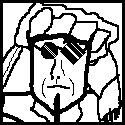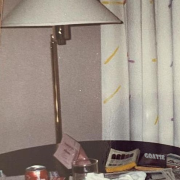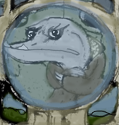|
Comrade Koba posted:Ready to lead yet another brigade of French pixelmans to death I'm sure you'll succeed this time Koba! famous last words
|
|
|
|

|
| # ? May 10, 2024 01:43 |
|
With the artillery brigade, are the artillery going to be seperate commands? One thing that limited us (and ended up screwing over zee germans) was the fear that the artillery would run away with the attached infantry.
|
|
|
|
 ALL THE CRUNCH ALL THE CRUNCHRight then. Last post was the fluff. Here's some crunchy rules to get your teeth into. TIME OF DAY Daytime updates will be 8 turns in duration. Nighttime updates will be 16 turns. Each turn represents, as before, half an hour of real time. The battle begins with Turn 1 at 8am, full daylight. Twilight is at 7pm, nightfall at 8pm, pre-dawn at 7am. Where possible, please refer to turn numbers, not time of day. ARRIVAL OF YOUR FORCES The Armoured Car Brigade (more on that in a moment) enters the field on Turn 1. One cavalry brigade arrives on Turn 4, and a second on Turn 10. They may enter at any point on the relevant map edge. NEW RULES: Brigades A Fully-Autonomous Brigade has no brigade command chit, and is not subject to the restrictions on Battle Order/Marching Order or Attack/Defend stance. They may attempt to change orders at any time, but must make a roll. A Semi-Autonomous Brigade has no brigade command chit, and is not subject to the restrictions on Battle Order/Marching Order or Attack/Defend stance. However, to change orders, they must be near an existing HQ chit. A brigade with a company within 8" of a HQ changes orders on the turn the order change succeeds; within 16", after a one-turn delay; within 24", a two-turn delay, and so on. Autonomous Brigades have their own individual sets of Standing Orders - look out for those in a few days, once you get to the point of giving brigade orders. Armoured Cars  This is an armoured car. Mechanically, it's a turbocharged MG chit. The Armoured Car Brigade is an elite Fully-Autonomous Brigade with ten armoured car chits. An armoured car moves at 24" while on a road, 4" while off-road, and may not self-entrench. In all other regards, it functions like a cavalry MG chit; it has 16" of vision, firing range of 12", it can fire through friendly units, and it can only open fire if it does not move at all during a turn. There are ten companies in the Armoured Car Brigade; here they are, in their "Rugger Ball" formation. 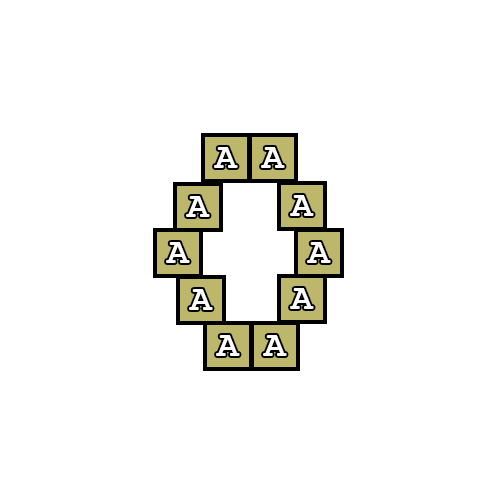 Artillery and Engineering Brigades Artillery and Engineers will, when they arrive, be organised into their own Semi-Autonomous Brigades, not attached to existing infantry brigades as in the previous round. (See below for details on what they can do.) They cannot rout after failing a morale check, but they can be forced to retreat suppressed. Cavalry Brigades Here is a British cavalry brigade, in its somewhat off-colour formation. A message to the Germans, I suppose. It has a brigade commander and functions as a normal brigade. 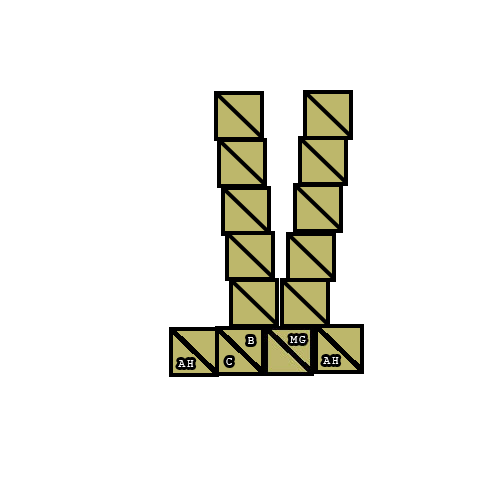 Infantry Brigades Here is a British infantry brigade, in the British standard "Teacup" marching formation. 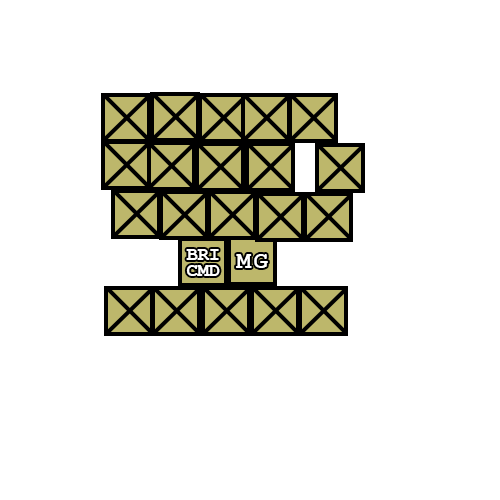 Unless otherwise mentioned, British infantry brigades are all Veteran units. You will also notice that they have five additional infantry companies compared to a French brigade. NEW RULES: Fatigue The fatigue day begins and ends at 0800. Any brigade which has one of its companies either open fire or is fired on gains a point of fatigue the next time 0800 rolls around; a brigade can only gain or lose one point of fatigue per day. A brigade loses a point of fatigue if it neither opens fire nor is fired on during a fatigue day. A brigade with 2 or more points of fatigue is easier to hit, and is less likely to hit the enemy. Fatigue rules do not apply to Autonomous Brigades. NEW RULES: Terrain There are five new types of terrain introduced in this round; water, bridges, fords, the depression, and the sunken road. Water Water is impassable at all times to all units. A chit may only cross water at a designated crossing point. Bridges Companies may cross a bridge without a movement penalty, but must do so in single file. Bridges may be built or demolished by Engineers (see below), and may not be damaged in any other way. If a bridge is demolished while a company is on the bridge, that company is killed. Fords Companies may cross a ford which is also part of a road without penalty, but must do so in single file. If the ford is not part of a road, the company stops immediately on reaching the edge of the ford and loses the rest of its movement for that turn; it may proceed across the ford on the following turn. Fords may not be demolished. The depression On the left of the map is a large depression, the Saucisson Vallee. The depression has a 4" zone around it. All companies inside the depression are invisible to companies outside the depression. All companies outside the depression are invisible to companies inside the depression. A company inside the 4" zone spots into the depression, and be spotted by companies inside the depression, at normal unmodified range. The sunken road On the right of the map is the Chemin Creux, a sunken road. A company located on the Chemin Creux has spotting and protective cover. If an Entrenchment is dug inside the Chemin Creux, it gives additional protection, and blocks other units from moving along the road at their usual movement rate. NEW RULES: Indirect Fire Right, here's a big one. Let's do the exception first: arse hortillery may not use indirect fire under any circumstances. For everyone else. All artillery pieces are organised into Semi-Autonomous Brigades. Your artillery may still use direct fire according to the rules, and is still subject to the rules about limbering and unlimbering. However, it may also use indirect fire when directed to do so. Indirect fire range is currently 40". All guns in a brigade must fire at once, and target an area equivalent to the number of chits in the brigade. (So, a brigade with one gun targets a 50px single-chit sized square; a brigade with four guns can arrange four 50px target squares however it likes; a brigade with eight guns can arrange eight squares, and so on.) Friendly fire is possible when using Indirect Fire. If units from opposing sides are within 2" of the target, I will determine who, if anyone, gets hit by the fire. Guns using Indirect Fire must still have 2" of clearance in order to fire over the head of friendly units. Ordered Fire An artillery brigade may use Ordered Fire on any turn when it is unlimbered. The relevant Artillery Commander selects a point to be targeted (subject to a Change of Orders roll if required) and the turn on which the guns should fire, and as long as the orders get through, the guns will open fire on that point. Supporting Fire An artillery brigade may be set to Supporting Fire by its commander. When another brigade spots the enemy, they will send a message to the artillery, and the artillery may then target and use Indirect Fire against the enemy companies. This is subject to the same 8"/16"/24" (and etc.) time lag as for a Change of Orders. The closer you put your guns to the infantry, the quicker they respond, but the more likely they are to be overrun by an enemy breakthrough... Limited Ammunition Owing to the difficulty of supply, the shortfall in munitions manufacture, and the prolific use of shells already in the war, your artillery brigades are limited to no more than 12 indirect fire missions per day. There is, at present, no limit on the number of Direct Fire missions you may use. Your ammunition comes up at 0800 each day. Standing Orders Artillery brigades will have their own set of Standing Orders, which I'll figure out before you start giving brigade-level orders. ALTERED RULES: Engineers and Entrenching The soil on this map is much less favourable to digging than on the previous map. Therefore, it now takes 10 turns for a brigade to self-entrench, 8 turns for an Engineer to dig a trench, 6 turns for the Engineer to put up 3" of barbed wire, and 4 turns to build a Roadblock. It takes 12 turns to wire a bridge for demolition and 14 turns to build a temporary bridge. Engineers are organised into a Semi-Autonomous Brigade; you will see mounted engineers, who move about the map as cavalry, as well as foot engineers. They now carry 9" of wire (their total carrying capacity) onto the field with them, may still requisition wire from Farms, and receive 3" of extra wire from the rear at 0800 each day. Two mounted engineers will enter the field on Turn 4; and two foot engineers will enter on Turn 16. ALTERED RULES: Hill Spotting The only high ground on the map is in the far east; units on the high ground have a spotting range of 24", as long as they are within unmodified spotting range of the edge of the hill. That's all for now. I'm sure there's other things that should go here, but I can't think of them just at the moment. Questions welcome. Remember to post in here and not hide in Roll20. Trin Tragula fucked around with this message at 00:20 on Mar 7, 2017 |
|
|
|
Bloody Marvelous. Loel for Corps command. No reflection on my dad's performance, just sharing the top job around.
|
|
|
|
Out of curiosity, why do people want me to be corps commander? (I'm partially doing this to solicit opinions about how I did last time, so feedback is definitely appreciated)
|
|
|
|
In roll20 as Effigies
|
|
|
|
xthetenth posted:Out of curiosity, why do people want me to be corps commander? You got covered in glory, and people are hoping it will rub off on the army.
|
|
|
|
xthetenth posted:Out of curiosity, why do people want me to be corps commander? Honestly? A mix of three things. One: You're generally capable of looking at the larger picture, even if you stumble a bit here and there. Two: You're a generally chill guy who can be nice and listen to people, but can also be firm in order to make a point and stand up to someone you disagree with. Three: HERO OF THE REPUBLIC
|
|
|
|
Man, the Armoured Car brigade looks amazing. Its a shame they're on field first, there won't be many left by the end of the day.
|
|
|
|
I just realised that was probably the wrong thread so, Spectralent on R20, same as here.
|
|
|
|
I am in to join as whatever, since I'm an idiot about my free time. ewie on roll20.
|
|
|
|
Slim Jim Pickens posted:Man, the Armoured Car brigade looks amazing. Its a shame they're on field first, there won't be many left by the end of the day. Yeah, they're going to be clutch for breaking up enemy attacks if we can keep any of them alive. I'll be paying a lot of attention to their initial orders, I think.
|
|
|
|
Quoting Trin: This battle contains a fatigue mechanic that only kicks in if the battle goes into a third day
|
|
|
|
Hunt11 posted:Quoting Trin: This battle contains a fatigue mechanic that only kicks in if the battle goes into a third day Hopefully they will survive long enough to get sleepy.
|
|
|
my dad posted:Well now, this sounds super fun. I have like no mechanical idea how this game works yet should i get involved mydad
|
|
|
|
|
Ramc posted:I have like no mechanical idea how this game works Neither do I. If you want to join us, welcome aboard, Ramc.  I can't quite offer you the comforts of Boatmurdered Arena, but the HQ staff room does have significantly less vomit all over it. I can't quite offer you the comforts of Boatmurdered Arena, but the HQ staff room does have significantly less vomit all over it.e: Make a roll20 account and join us.
|
|
|
|
Here's our commanding officer, by the way, if you want some ww1 trivia.
|
|
|
|
I support Loel for Corps command
|
|
|
|
Current vote total: My dad: 5 Curly: 2 Loel: 4
|
|
|
|
quote:Companies may cross a bridge without a movement penalty, but must do so in single file. Bridges may be built or demolished by Engineers (see below), and may not be damaged in any other way. If a bridge is demolished while a company is on the bridge, that company is killed. If a brigade is in marching order, does it simply waltz across the road bridge like it ain't no thing? Or does it have to go into single file while crossing the bridge, and then automatically resume the marching order formation once it is over the bridge? I recall that the traditional French "wine glass" formation isn't single file, for example.
|
|
|
|
For those interested, this is the (rough) historical makeup of 3rd Cavalry Division. 6th Cavalry Brigade 1st (Royal) Dragoons 10th (Prince Of Wales’s Own Royal) Hussars 3rd (Prince Of Wales’s) Dragoon Guards 1/1st North Somerset Yeomanry C Battery, RHA 6th Cavalry Brigade Machine Gun Squadron, MGC 7th Cavalry Brigade 1st Life Guards 2nd Life Guards Royal Horse Guards 1/1st Leicestershire Yeomanry K Battery, RHA 7th Cavalry Brigade Machine Gun Squadron, MGC Engineers 1st Field Squadron, Royal Engineers Armored Cars Samson’s Armored Car Squadron, (Royal Naval Air Service) RNAS.
|
|
|
|
Unformatted list of questions for Trin: Can Armoured Cars dismount (And be able to hide and move like infantry)? Do the road crossings in the middle river count as bridges or fords (Just wanted the answer in the thread) How does our deployment zone change if the Germans get close to it? Can we control the chits of a fully-autonomous brigade even if they're spread all over the map? If an armoured car brigade wants to use a road, how many chits wide can that formation be? If you dig trenches on roads, does that gently caress up the qualities of the road or the qualities of the trench? Slim Jim Pickens fucked around with this message at 07:36 on Mar 7, 2017 |
|
|
|
Also, Trin. Are our cavalry and armored cars veteran units as well?
|
|
|
|
First, let me start with this https://20thcenturywargaming.wordpress.com/2013/06/16/why-cold-war-warsaw-pact-tactics-work-in-wargaming/ quote:Why Cold War Warsaw Pact Tactics Work In Wargaming Now, looking at the map, we can take a few things into consideration.  As you recall, they zergrushed to their core city last game, and tried to rush the final location ignoring all losses. So we can label their doctrine as aggressive, particularly since it got them the (marginal) win last game. For this map, what does it mean?  My contention, then, is that their approach will look something like this. Bikes rush as fast as they can to the first beachhead they could, which the Staff say they can do by turn 5-6. They can set up arty on the hilltops and infantry in the city on the way. The question for us, then, is what can and should we do by turn 5? edit: Based on our orders and timetables, this seems like a possible approach:  All speed down the center lane with our fastest troops, meet them outside Stethoscope. Loel fucked around with this message at 06:36 on Mar 7, 2017 |
|
|
|
We want to avoid Stethoscope since they will have cover and we won't. My proposal is something like this, at least for the cavalry: The armored cars race for the southern sunken road and reach it by turn 5. They ambush the enemy, spending 2 turns unloading at any enemy brigades marching up into stethoscope, using the sunken road to protect them from whatever retaliation the enemy manages to put up on the second turn. Then they split into two equal groups, depending on survivors, and race to the fall-back positions labelled "2" where they spend one turn shooting at the enemy, before falling back to position 3. The first cavalry brigade races to the "1st cavalry ambush", while the second one races to the "2nd cavalry ambush site" and tries to hide in the woods and lay an cavalry-charge ambush for the enemy as they cross the fords of the middle river. We want to let some enemy get across so we can wreak havoc amongst them without being vulnerable to a counter-charge. After the charge, we fall back into the woods and use rifles and arse hortillery to keep the enemy on the other side of the river. With the goal to keeping them on the far side of the middle river for the first day and night. The surviving ACs will gather on the middle road and try to defend those crossings as best they can with their MGs. Obviously, we will have a better picture of where things unfold at that time, but we should try to get our engineers to lay a fortified fall-back position as pictured between tres freres and bois de coq, although the infantry will try to help the cavalry hold them off at the middle river if possible to give the engineers as much time to dig trenches and lay wire along that fortified zone. We can station the arty in the area behind the fortified zone once it arrives. Assumptions: The Germans will have a fast brigade marching to reach Stethoscope as quickly as possible, probably a cav brigade, and the following brigades will be strung out along the roads, allowing us to maul the lead brigade without having to face overwhelming return fire. If we can ambush the Germans, we will get one free round of shooting at the enemy, and many of their rifles will not be able to retaliate on the second round, since they will be moving towards us. If facing arse hortillery, we will be in some danger from that, but we will rely on the sunken road's protection for the one round we have to face it. I know you are concerned about abandoning half of the map to the enemy; but consider this. The sunken road is too powerful a defensive position, and if we cannot seize it from the beginning, it will be best not to allow the enemy to use it against us. This means withdrawing more than 12" away from it. The next best obstacle is the middle river; the fords will slow down attempts to cross it, so if we wait until an enemy brigade is strung out crossing the ford, we will be able to cavalry charge it from the forest, wiping it out without danger of being fired upon. We can then fall back to the forest and hinder the following enemy brigades as we hold the line of the river. This will be a powerful defensive position until we can bring engineers up to construct a much better one. I fear that the enemy may be coming in great numbers, and so we may need to be prepared to have a fighting retreat to the fall-back trenches. If we can entrench in the forest, by all means, we will do so, and we can instruct the engineers and artillery to move forward if we have been able to hold the enemy at the river.
|
|
|
|
That doesnt look too bad.
|
|
|
|
That plan looks good. Would we be using the engineer brigade to create the fallback line or are we rushing forward to try and blow a bridge?
|
|
|
|
If we blow the southernmost bridge, won't that pretty much force them to advance directly into any ambushes we may prepare in Foret de Effadyers and Bois de Blob?
|
|
|
|
Engineers arrive late and will take 12 turns to rig the bridge to blow. See the engineer stuff in Trin's post. It makes destroying the bridges on their end not something we can realistically do at the start of the game without knowing their force composition, and it's not really something we can plan for at this stage.
|
|
|
|
AbortRetryFail posted:Engineers arrive late and will take 12 turns to rig the bridge to blow. See the engineer stuff in Trin's post. It makes destroying the bridges on their end not something we can realistically do at the start of the game without knowing their force composition, and it's not really something we can plan for at this stage. Uh, right...maybe we could have the engineers ride shotgun in the armored cars?
|
|
|
|
Tally ho pip pip old chaps...I'd like to sign up to command a brigade. Apparently I need to sign up on roll20, or something? but I don't see anything about that in the OP, am I blind and/or stupid? Edit: display name is feedmegin on Roll20. feedmegin fucked around with this message at 14:14 on Mar 7, 2017 |
|
|
|
Are units in the sunken road visible while firing? While not firing?
|
|
|
|
Here's the link you're looking for: https://app.roll20.net/join/2004056/9ONgKg
|
|
|
|
Slim Jim Pickens posted:Unformatted list of questions for Trin: No. quote:Do the road crossings in the middle river count as bridges or fords (Just wanted the answer in the thread)  THEY ARE ALL FORDS, ALL OF THEM, EVEN THE ONES WITH A ROAD LEADING UP TO THEM, THEY ARE FORDS, THEY ARE FORDS THEY ARE ALL FORDS, ALL OF THEM, EVEN THE ONES WITH A ROAD LEADING UP TO THEM, THEY ARE FORDS, THEY ARE FORDSquote:How does our deployment zone change if the Germans get close to it? This is above your pay grade; all you know is that it will shrink if your boss thinks it's too dangerous to deploy men there. quote:Can we control the chits of a fully-autonomous brigade even if they're spread all over the map? Yes. That's part of the point of making them fully autonomous. quote:If an armoured car brigade wants to use a road, how many chits wide can that formation be? The Rugger Ball formation is just my little joke; if they all want to use the same bit of road together, they advance in single file, 1x10. quote:If you dig trenches on roads, does that gently caress up the qualities of the road or the qualities of the trench? An excellent and cromulent question; it fucks up the road, not the trench. Since you are carrying the necessary equipment for entrenching in crappy wet soil (no, proximity to water does not matter), it is assumed that you build a breastwork on top of it. ViggyNash posted:Are units in the sunken road visible while firing? While not firing? They have both spotting and protective cover and obey the usual rules for a unit in cover.
|
|
|
|
Trin Tragula posted:
bullshit, you said they were rolls-royces Trin Tragula posted:breastwork hur hur hur
|
|
|
|
Can you move in marching order over a bridge/do bridges count as roads, or is it a thing you have to advance over more slowly? Similarly, if crossing a road-ford, does the road part take priority as far as moving with marching order?
|
|
|
|
 VOTING CLOSES IN TWO HOURS VOTING CLOSES IN TWO HOURS
|
|
|
|
I'd like to put my hand up now for command of 7th Infantry Division when they arrive. If one of the new players would prefer division command I'll accede to them and take an infantry brigade instead.
|
|
|
|
professor_curly posted:Can you move in marching order over a bridge/do bridges count as roads, or is it a thing you have to advance over more slowly? Similarly, if crossing a road-ford, does the road part take priority as far as moving with marching order? If you get fired on, you cross individually in single file; otherwise you can just stroll over as though they were roads.
|
|
|
|

|
| # ? May 10, 2024 01:43 |
|
Voting for Loel. New map, new general with some spiffy new red tabs.
|
|
|














